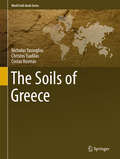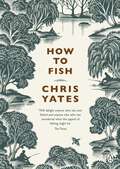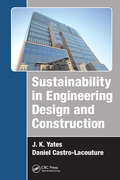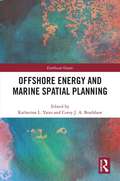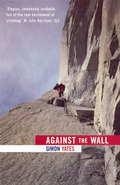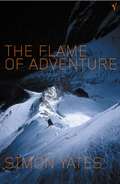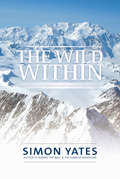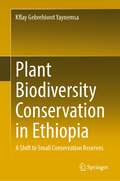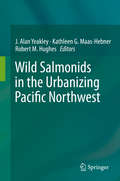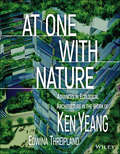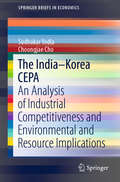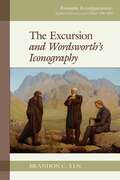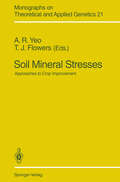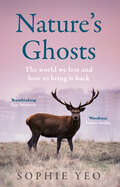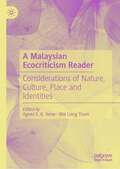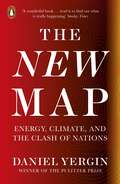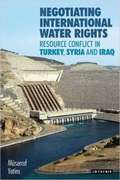- Table View
- List View
The Soils of Greece (World Soils Book Series)
by Nicholas Yassoglou Christos Tsadilas Costas KosmasThis book presents a comprehensive and up-to-date overview on soils of Greece. It includes sections on soil research history, climate, geology, geomorphology, major soil types, soil maps, soil properties, soil classification, soil fertility, land use and vegetation, soil management, soils and humans, soils and industry, future soil issues. The book summarizes what is known about the soils in Greece in a concise and highly reader-friendly way.
Multidisciplinary Studies of the Environment and Civilization: Japanese Perspectives (Routledge Studies on Asia and the Anthropocene)
by Yoshinori Yasuda Mark J. HudsonMultidisciplinary Studies on the Environment and Civilization draws on research from a diverse range of fields across the humanities, social and natural sciences to discover what is needed to develop an affluent, sustainable and resilient world for the twenty-first century and beyond. The contributions throughout this volume build and promote frameworks for an interdisciplinary approach to sustainability both in and beyond Japan. Utilizing research efforts from a broad range of fields such as zoology, biological anthropology and archaeology, these multidisciplinary studies are brought together to assess the impacts humans have had on the environment as well as the role of civilization, culture and heritage in environmental history. This book provides a truly multidisciplinary approach to environmental issues and will be of great interest to graduate students and researchers in fields such as climate, geology, plant taxonomy and marine science as well as those with an interest in Japanese history, archaeology, art and literature.
Multidisciplinary Studies of the Environment and Civilization: Japanese Perspectives (Routledge Studies on Asia and the Anthropocene)
by Yoshinori Yasuda Mark J. HudsonMultidisciplinary Studies on the Environment and Civilization draws on research from a diverse range of fields across the humanities, social and natural sciences to discover what is needed to develop an affluent, sustainable and resilient world for the twenty-first century and beyond. The contributions throughout this volume build and promote frameworks for an interdisciplinary approach to sustainability both in and beyond Japan. Utilizing research efforts from a broad range of fields such as zoology, biological anthropology and archaeology, these multidisciplinary studies are brought together to assess the impacts humans have had on the environment as well as the role of civilization, culture and heritage in environmental history. This book provides a truly multidisciplinary approach to environmental issues and will be of great interest to graduate students and researchers in fields such as climate, geology, plant taxonomy and marine science as well as those with an interest in Japanese history, archaeology, art and literature.
Nightwalk: A Journey To The Heart Of Nature
by Chris YatesChris Yates, one of Britain’s most insightful and lyrical writers, raises his gaze from his beloved rivers and ponds and takes us on a mesmerizing tour of the British countryside.
How to Fish
by Christopher YatesSitting on a riverbank, with rod and line, must count as one of the most relaxing and enjoyable – yet occasionally frustrating – experiences known to man.Chris Yates discovered the joys of fishing early in life and was quickly hooked by its pleasures. Many years later, he is still content to sit, day after day, observing the quirks of different fish and losing track of time. For him, fishing is much more than just a question of technique; sometimes it’s about listening to nothing but your instincts, and at other times it’s about enjoying the perfect cup of tea. And it’s always about not knowing how the day is going to unfold . . .There’s no better guide for the uninitiated – and no better companion for those already familiar with the satisfactions of fishing – than Chris Yates. And immersing yourself in How To Fish is almost as delightful an activity as fishing itself.
Sustainability in Engineering Design and Construction
by J. K. Yates Daniel Castro-LacoutureSuccessfully Measure the Benefits of Green Design and Construction Sustainability in Engineering Design and Construction outlines the sustainable practices used in engineering design and construction operations for all types of engineering and construction projects. Aimed at ushering the engineering and construction industry into embracing sustainable practices and green construction techniques, this book addresses sustainability in engineering design and construction operations from a historical and global perspective, and delves into specific sustainability concepts and processes. The book explains the concepts of sustainable development, corporate social responsibility (CSR), the Dow Jones Global Sustainability Index (DJGSI), key performance indicators (KPIs), corporate sustainability, and the triple bottom line (economic, environmental, and social values in design and construction). Relevant to sustainability in every facet of engineering and construction, it also covers life-cycle environmental cost analysis, discusses sustainable engineering and site selection, the economic considerations evaluated when making sustainability decisions, and explains how to measure and quantify sustainable performance and apply these practices in the real world. It also covers project and corporate level sustainability practices, sustainable construction materials and processes, sustainable heavy construction equipment, traditional and alternative energy sources, provides implementation resources for starting and evaluating sustainability programs, and includes a checklist for measuring the sustainability of construction operations. The text contains detailed information on sustainable construction materials and processes, heavy construction equipment, and traditional and alternative energy sources. It presents information on sustainable designs, selecting sustainable sites, designing for passive survivability, designing for disassembly, and the ISO 14,000 standards. It provides implementation resources for starting and evaluating sustainability programs and a checklist for measuring the sustainability of construction operations In addition, it provides definitions of sustainability terms and expressions, as well as case studies, examples, discussion questions, and a list of supplemental references at the end of each chapter. This book provides information on: Definitions for sustainability terms Sources for locating global sustainability requirements Current sustainability issues Environmental laws related to sustainability and their implications Sustainable design Life-cycle cost assessment models Sustainable practices currently being used in the engineering and construction (E&C) industry Corporate-level sustainability practices Project-level sustainability practices Global sustainability trends and implications Sustainable materials Sustainable heavy construction equipment Traditional and alternative energy sources LEED Green Building Rating System Sustainability organizations and certification programs Sustainability implementation resources A summary of sustainable engineering design and construction
Sustainability in Engineering Design and Construction
by J. K. Yates Daniel Castro-LacoutureSuccessfully Measure the Benefits of Green Design and Construction Sustainability in Engineering Design and Construction outlines the sustainable practices used in engineering design and construction operations for all types of engineering and construction projects. Aimed at ushering the engineering and construction industry into embracing sustainable practices and green construction techniques, this book addresses sustainability in engineering design and construction operations from a historical and global perspective, and delves into specific sustainability concepts and processes. The book explains the concepts of sustainable development, corporate social responsibility (CSR), the Dow Jones Global Sustainability Index (DJGSI), key performance indicators (KPIs), corporate sustainability, and the triple bottom line (economic, environmental, and social values in design and construction). Relevant to sustainability in every facet of engineering and construction, it also covers life-cycle environmental cost analysis, discusses sustainable engineering and site selection, the economic considerations evaluated when making sustainability decisions, and explains how to measure and quantify sustainable performance and apply these practices in the real world. It also covers project and corporate level sustainability practices, sustainable construction materials and processes, sustainable heavy construction equipment, traditional and alternative energy sources, provides implementation resources for starting and evaluating sustainability programs, and includes a checklist for measuring the sustainability of construction operations. The text contains detailed information on sustainable construction materials and processes, heavy construction equipment, and traditional and alternative energy sources. It presents information on sustainable designs, selecting sustainable sites, designing for passive survivability, designing for disassembly, and the ISO 14,000 standards. It provides implementation resources for starting and evaluating sustainability programs and a checklist for measuring the sustainability of construction operations In addition, it provides definitions of sustainability terms and expressions, as well as case studies, examples, discussion questions, and a list of supplemental references at the end of each chapter. This book provides information on: Definitions for sustainability terms Sources for locating global sustainability requirements Current sustainability issues Environmental laws related to sustainability and their implications Sustainable design Life-cycle cost assessment models Sustainable practices currently being used in the engineering and construction (E&C) industry Corporate-level sustainability practices Project-level sustainability practices Global sustainability trends and implications Sustainable materials Sustainable heavy construction equipment Traditional and alternative energy sources LEED Green Building Rating System Sustainability organizations and certification programs Sustainability implementation resources A summary of sustainable engineering design and construction
Offshore Energy and Marine Spatial Planning (Earthscan Oceans)
by Katherine L. Yates Corey J. A. BradshawThe generation of offshore energy is a rapidly growing sector, competing for space in an already busy seascape. This book brings together the ecological, economic, and social implications of the spatial conflict this growth entails. Covering all energy-generation types (wind, wave, tidal, oil, and gas), it explores the direct and indirect impacts the growth of offshore energy generation has on both the marine environment and the existing uses of marine space. Chapters explore main issues associated with offshore energy, such as the displacement of existing activities and the negative impacts it can have on marine species and ecosystems. Chapters also discuss how the growth of offshore energy generation presents new opportunities for collaboration and co-location with other sectors, for example, the co-location of wild-capture fisheries and wind farms. The book integrates these issues and opportunities, and demonstrates the importance of holistic marine spatial planning for optimising the location of offshore energy-generation sites. It highlights the importance of stakeholder engagement in these planning processes and the role of integrated governance, with illustrative case studies from the United States, United Kingdom, northern Europe, and the Mediterranean. It also discusses trade-off analysis and decision theory and provides a range of tools and best practices to inform future planning processes.
Against The Wall
by Simon YatesSimon Yates is 'the one who cut the rope' in Joe Simpson's award-winning account of their epic struggle for survival in Touching the Void. Afterwards, Yates continued mountaineering on the hardest routes. Perhaps the most testing of all was one of the world's largest vertical rockfaces, the 4, 000-ft East Face of the Central Tower of Paine in Chile. Battered by ferocious storms and almost crippled with fear just below the summit, Yates and his three companions are forced into a nightmare retreat. After resting in a nearby town, they return to complete the climb, but Yates knows he still has to face one of life's greatest challenges...
Flame Of Adventure
by Simon YatesSimon Yates, author of Against the Wall, takes us back to his early years as a climber - the escapades and excitement of a young life lived on the edge and for the moment, when experience was all-important and dramatic achievements and failures came as naturally as the hair-raising risks themselves.A mountaineering travelogue of dazzling variety, The Flame of Adventure moves from the camaraderie of deprived Russian climbers in the little-known peaks in the Tien Shan to the awesome experience of the North Face of the Eiger, from a rumbustious motorbike ride across Australia with a psychotic lorry driver. We meet a remarkable gallery of climbers, from Doug Scott to Joe Simpson, and, when not exploring high mountains, we enter the bizarre world of rope access workers: mavericks balancing high above building sites on the London skyline.
The Wild Within: Climbing The World's Most Remote Mountains
by Simon YatesAll mountaineers develop differently. Some go higher, some try ever-steeper faces and others specialise in a particular range or region. I am increasingly drawn to remoteness - to places where few others have trod.' The Wild Within is the third book from Simon Yates, one of Britain's most accomplished and daring mountaineers. With his insatiable appetite for adventure and exploratory mountaineering, Yates leads unique expeditions to unclimbed peaks in the Cordillera Darwin in Tierra del Fuego, the Wrangell St-Elias ranges on the Alaskan-kon border, and Eastern Greenland. Laced with dry humour, he relates his own experience of the rapid commercialisation of mountain wilderness, while grappling with his new-found commitments as a family man. At the same time he must endure his role in the film adaptation of Joe Simpson's Touching The Void, having to relive the events of that trip to Peru for an award winning director. Yates' subsequent escape to the some of the world's most remote mountains isn't quite the experience it once was, as he witnesses first hand the advance of modern communications into the wilderness, signalled by the ubiquitous mobile phone masts appearing in once deserted mountain valleys. He is left to dwell on the remaining significance of mountain wilderness and begins a journey to rediscover his own notion of 'wild'.
Plant Biodiversity Conservation in Ethiopia: A Shift to Small Conservation Reserves
by Kflay Gebrehiwot YaynemsaThis book covers biodiversity conservation under special consideration of the challenges in the global south with particular attention being paid to consider the existing conservation challenges in relation to the study area in Ethiopia. Key issues are addressed, such as the current and future threats to plant biodiversity in Ethiopia, as well as the single large or several small conservation approaches and which approach is feasible for Ethiopia. Furthermore, an innovative approach was developed that enhances ecological connectivity and promotes ecological restoration through community involvement. The book also covers why a systematic conservation planning approach is important and should be used in new protected area establishments, and also looks at the trends of plant ecology research over the past five decades, revealing research gaps and suggesting future research topics. Despite its focus on Ethiopian plant diversity, abundant examples were used from different continents making this book attractive to global readers. It will be of interest for policy- and decision-makers in the conservation sector, researchers interested in biodiversity, climate change, conservation and sustainable use of natural resources, and would be a valuable resource for university students.
Wild Salmonids in the Urbanizing Pacific Northwest
by J. Alan Yeakley Kathleen G. Maas-Hebner Robert M. HughesWild salmon, trout, char, grayling, and whitefish (collectively salmonids) have been a significant local food and cultural resource for Pacific Northwest peoples for millennia. The location, size, and distribution of urban areas along streams, rivers, estuaries, and coasts directly and indirectly alter and degrade wild salmonid populations and their habitats. Although urban and exurban areas typically cover a smaller fraction of the landscape than other land uses combined, they have profound consequences for local ecosystems, aquatic and terrestrial populations, and water quality and quantity.
At One with Nature: Advances in Ecological Architecture in the Work of Ken Yeang
by Ken Yeang Edwina Threipland"At One with Nature is an inspiring collection of the latest work of Ken Yeang that further advances sustainable architecture and design. This collection features recent projects as he explores how we can achieve harmony between the natural and our built environments to create a better planet by design. Each project features and highlights not only the systems and devices adopted, but also outlines the intentions and ecological considerations demonstrating best practices for how we can proceed moving forward. The book role models our living Earth and shows how we can behave as stewards of our planet."--Cassia Patel, Oceanic Global Foundation At One with Nature showcases Ken Yeang's latest ideas, built projects designs, research work and advances in the field of designing with nature, a topic that Yeang has pioneered and developed over many decades since receiving his doctorate in ecological design and planning from Cambridge University. His ideas and work are even more pertinent today with the current state of devastation of Earth's natural systems and a biogeochemical cycle that has been extensively and severely impacted by human society. The global environment today is in a state of crisis, but what can society do to address the issues? Yeang's recent projects are presented with instructive diagrams that provide a basis for action for architects, planners, designers, engineers, and anyone whose daily work impinges on the natural environment. Offered in a highly visual, annotated format, with instructive illustrations of Yeang's theoretical books on the topic, At One with Nature is an invaluable resource that students and academics interested in designing with nature will find both informative and relevant.
Cultures of Environmentalism: Empirical Studies in Environmental Sociology
by S. YearleyAs environmental issues increasingly impinge on society, sociologists have turned their attention to nature and the environment. However, unlike the majority of sociological work on environmental issues, which has too often been dominated by abstract theoretical disputes, this book concentrates on empirical studies in environmental sociology. It shows what sociologists can bring to current debates over environmental topics (including genetic modification) and - using the author's first-hand research - demonstrates how sociologists can best pursue practical work on environmental topics.
The India–Korea CEPA: An Analysis of Industrial Competitiveness and Environmental and Resource Implications (SpringerBriefs in Economics)
by Sudhakar Yedla Choongjae ChoThis book assesses the changes that the Comprehensive Economic Partnership Agreement (CEPA) could produce by boosting the competitiveness of firms in India and Korea. It evaluates the CEPA in terms of its effects on the environment and natural resources of the importing and exporting countries alike. Further, it employs the revealed comparative advantage (RCA) and relative trade advantage (RTA) methods of analysis to gauge the influence of the CEPA on industrial competitiveness in both host and receiving countries. While the CEPA would increase trade between India and Korea in their respective strong domains, the book argues that, given the nature of the exported and imported goods and products, India would be more susceptible to serious environmental impacts than would Korea. The book subsequently presents these impacts in a qualitative framework and stresses the need for a comprehensive valuation of not only environmental impacts, but also the losses due to tariff cuts and the gains due to increased trade between the two countries.
The Physical Geography of Mongolia (Geography of the Physical Environment)
by Batchuluun YembuuThis book gives the most detailed and comprehensive physico-geographical overview of the very unique country of Mongolia. The country offers diverse geographical features and natural landscapes combined with a long history. This book offers integrated and systematical research on the geophysical characteristics of Mongolia with an academic orientation. It provides the readers with general knowledge of the physical geography of Mongolia as well as new results of the latest research. The volume consists of 11 chapters, each written by field experts, with contributions from scientific researchers from Mongolia.The topics covered: geological and geomorphological characteristics and processes, landscapes and landforms, climate and climate change, hydrology, glaciers and permafrost, soils, environmental changes, biodiversity and many other aspects of physical geography in Mongolia.The book appeals to researchers and students of geography and related fields and can serve as a guide for field trips to Mongolia or basic literature for research projects.
The Excursion and Wordsworth’s Iconography (Romantic Reconfigurations: Studies in Literature and Culture 1780-1850 #5)
by Brandon C. YenThis book considers William Wordsworth’s use of iconography in his long poem The Excursion. Through the iconographical approach, the author steers a middle course between The Excursion’s two very different interpretive traditions, one focusing upon the poem’s philosophical abstraction, the other upon its touristic realism. Fresh readings are also offered of Wordsworth’s other major works, including The Prelude.Yen explores Wordsworth’s iconography in The Excursion by tracing allusions and correspondences in an abundance of post-1789 and earlier verbal and pictorial sources, as well as in Wordsworth’s prose and poetry. He analyses how the iconographical images in The Excursion contribute to, and impose limitations on, the overarching preoccupations of Wordsworth’s writings, particularly the themes of paradise lost and paradise regained in the post-revolutionary context. Shedding light on a vital aspect of Wordsworth’s poetic method, this study reveals the visual etymologies – together with the nuances and rhetorical capacities – of five categories of apparently ‘collateral’ images: envisioning, rooting, dwelling, flowing, and reflecting.
Soil Mineral Stresses: Approaches to Crop Improvement (Monographs on Theoretical and Applied Genetics #21)
by Anthony R. Yeo Timothy J. FlowersNature’s Ghosts: The world we lost and how to bring it back
by null Sophie YeoWhat history can teach us about how to avoid ecological catastrophe ‘Sophie writes fantastically, chronicling the most important issues facing nature conservationists today.’ Chris Packham For thousands of years, humans have been the architects of the natural world. Our activities have permanently altered the environment – for good and for bad. In Nature’s Ghosts, award-winning journalist Sophie Yeo examines how the planet would have looked before humans scrubbed away its diversity: from landscapes carved out by megafauna to the primeval forests that emerged following the last Ice Age, and from the eagle-haunted skies of the Dark Ages to the flower-decked farms of more recent centuries. Uncovering the stories of the people who have helped to shape the landscape, she seeks out their footprints even where it seems there are none to be found. And she explores the timeworn knowledge that can help to fix our broken relationship with the earth. Along the way, Sophie encounters the environmental detectives – archaeological, cultural and ecological – reconstructing, in stunning detail, the landscapes we have lost. Today, the natural world is more vulnerable than ever; the footprints of humanity heavier than they have ever been. But, as this urgent book argues, from the ghosts of the past, we may learn how to build a more wild and ancient future.
Environmental, Social and Governance (ESG) Laws, Regulations and Practices in the Digital Era
by Peter YeohIn the past two decades, the traditional role of corporate governance has been greatly augmented and transformed by increased attention to the importance of social inclusion in business decisions and of environmental impacts of business activities, giving rise to the now well-understood linkage among environmental, social, and governance (ESG) principles. This book is the first to thoroughly analyze the ESG phenomenon as a tripartite corporate purpose model and the profusion of laws and regulations it continues to engender. Drawing on perspectives from law, economics, and business management, the book focuses on those ESG challenges that are most likely to impact companies in the coming years. The author discusses such aspects of ESG law, regulation, and practice as the following: impact of digitalization on ESG practices; competing ESG perspectives and whether there are signs of convergence toward a more universal model; impact of corporate ownership patterns; review of hard and soft law responses; corporate control under COVID-19 pandemic conditions; workplace and workforce transformations; various ESG-related corporate scandals and controversies; ESG regulatory responses from international entities such as the Organisation for Economic Co-operation and Development (OECD) and International Organization of Securities Commissions (IOSCO); and seminal ESG cases in various business sectors. The emphasis throughout is on developments in the European Union, the United States, and the United Kingdom, both because it is in those jurisdictions that ESG challenges have been and are most fully dealt with and because these economies taken together are likely to continue exerting dominating influence across the world. What this book says about ESG provides pertinent insights and guidance for those seeking a better understanding of ESG practices and underlying theories across major economies. With essential information and guidance for ESG law practitioners, policymakers, and academicians, the book gives clarity and guidance as to who should lead the charge for ESG practices in business enterprises in major jurisdictional settings. Its detailed coverage of best ESG practices will be welcomed by those conducting their business enterprises within approved regulatory perimeters.
A Malaysian Ecocriticism Reader: Considerations of Nature, Culture, Place and Identities
by Agnes S. K. Yeow Wai Liang ThamThis collection of essays brings together ecocritical interpretations of Malaysian texts – including fiction, nonfiction, and other media / cultural expressions. It includes original works by environmental activists as well as emerging and established scholars, who collectively analyse various aspects of Malaysian ecological discourse.The contributors address crucial – and often controversial – topics such as local ecological imaginations, wildlife conservation, overdevelopment, postcolonial ecological identities, biopolitics, nature and sexuality, nature and race, the commodification of nature, nature–culture embodiments and entanglements, human–animal relations, waste and materiality, human and other-than-human agency, toxicity and slow violence, self-representations as well as attitudes towards land, nativity and indigeneity, migrancy and diaspora.Readers will gain valuable insights into the ways in which environments and ecological relationships are mediated within this national space, while opening up room to theorise beyond its boundaries.
The New Map: Energy, Climate, and the Clash of Nations
by Daniel YerginThe Pulitzer Prize-winning author of The Prize and The Quest reveals how climate battles and energy revolutions are mapping our futureA new type of Cold War is emerging between China and the West. . The global order is being simultaneously shaken by climate change and the shale revolution in oil and gas - and now by the coronavirus. Controversial fracking technology has given America unprecedented leverage as the world's leading energy powerhouse, ahead of Saudi Arabia and Russia, upending the chessboard of global politics and changing the psychology of the global economy. Despite being weighed down by sanctions, Russia is pivoting east toward China as Vladimir Putin and Xi Jinping unite to challenge America and lay claim to almost all of the South China Sea, one of the world's most critical trade routes. Elsewhere, the map of the Middle East created after World War I is being attacked by ISIS and Iran's Revolutionary Guards as the region struggles to come to grips with the recent oil price collapse caused by the rise of shale. Oil producers, from the Middle East and Moscow to corporate boardrooms around the world, now fear that peak demand for oil is coming as renewable energy vies with fossil fuels.The New Map tells a sweeping story about how the role of energy in climate change is shaping geopolitical discussions, challenging our industries and our lifestyles, and accelerating a second energy revolution - the quest for renewables. It also brings realism to the debates over the energy transition.
Negotiating International Water Rights: Natural Resource Conflict in Turkey, Syria and Iraq
by Muserref YetimTransboundary watercourses account for an estimated 60 per cent of global freshwater flow and support the livelihoods of hundreds of millions of people worldwide. Yet the indeterminate status of water rights in many international watercourses presents a problem and many attempts to resolve water rights issue have failed. Knowing how and where negotiations fail is essential if successful resolution is to be achieved. Muserref Yetim's important book seeks to illustrate a means to the peaceful resolution of natural resource based conflicts. Through a detailed study of the Tigris-Euphrates water conflict, involving Turkey, Syria and Iraq, countries of vital security interest to the world at large, the author clarifies the collective action dilemmas confronting Middle Eastern watercourses and reveals the bargaining bottlenecks where negotiations fail. She develops an original framework that explains bargaining failures and proposes conditions for creating a new property rights regime among watercourse states that offers a route to governing their shared water resources in ways that are politically, economically and environmentally sound. In almost all water scarce regions, international water resources are subject to intense unilateral exploitation in a highly competitive fashion. And as demand for freshwater continues to increase, through increasing urbanization and the continuing development of societies, so the issue of how such shared water resources can best be governed is becoming vitally important. Negotiating International Water Rights offers both a timely contribution to a matter of international concern and important insights into resource conflict in countries of vital security interest to the world at large.
The Politics of Nuclear Energy in China (Energy, Climate and the Environment)
by X. Yi-chongExplores the history and challenges of nuclear energy development in China, across five main areas: politics, economics, environment, technology transfer and the nuclear fuel cycle. It emphasizes the political challenges in developing a set of long-term national strategies to ensure speedy, safe and secure nuclear energy development.
